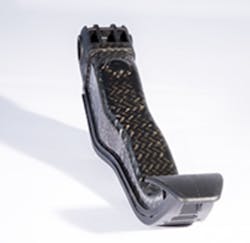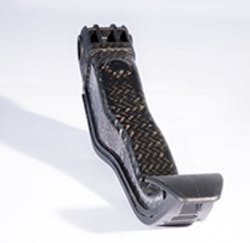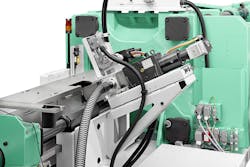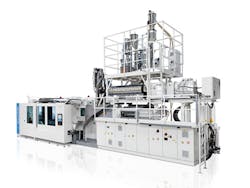Injection molding compounding offers savings, alternatives to metal auto parts
Injection molding compounding, direct injection of long fibers and thermoplastic RTM processes are new ways to make plastic parts designed to replace metal in structural automotive applications.
The goal is to create a fiber-reinforced part that advances lightweighting goals, provides process flexibility and shorter injection molding production times compared to metal or thermoset part making while maintaining part strength.
WHAT'S OUT THERE
Injection molding compounding (IMC) — which links a twin-screw compounding extruder to an injection press — is one path to manufacturing reinforced parts that deliver the mechanical properties of metal without the weight, at a lower cost and at production rates similar to molding a pre-compounded reinforced pellet. KraussMaffei Group, Munich, is promoting this technology to create parts
containing long fiber strands for higher mechanical properties.
In another approach from Arburg GmbH & Co. KG, Lossburg, Germany, long glass fibers are introduced through the barrel of the injection unit. Engel and KraussMaffei have developed hybrid thermoplastic resin transfer molding processes that produce high-strength reinforced parts at higher volumes than the thermoset-style systems from which they are adapted.
Reactive systems such as sheet molding compound, glass-mat thermoplastics, pellets compounded with fiber as well as traditional resin transfer molding are the targets these newer methods are looking to replace. Automotive interior, exterior and under-the-hood structural applications are the initial markets.
"The objective is developing new processes — often in connection with new material systems — that achieve the productivity and cost efficiency levels demanded in the car industry," says Peter Egger, director of Engel Austria's technology center for lightweight composites.
These new approaches — advanced with new screw designs and gentler injection or by incorporating sheets impregnated throughout with fibers — minimize or eliminate damaging shear to the fibers during melt preparation. This allows for parts retaining fiber lengths of 10mm or more, compared with 2mm to 3mm for standard injection molding using long-fiber pellets. Longer fiber length enhances mechanical load bearing capacity.
These new-generation reinforced thermoplastic parts perform similar to metal when it comes to distortion, creep and energy absorption.
"A noticeable effect on part strength and toughness is achieved with fiber lengths exceeding 2mm," says Paul Caprio, president and managing director of KraussMaffei Corp., the U.S. subsidiary in Florence, Ky.
AT-THE-PRESS OEM SUPPLIERS
Arburg's long-fiber direct injection molding technology is the newest at-the-press compounding injection solution, designed for high volume production of high-strength glass-reinforced thermoplastic parts for automotive. It was developed together with SKZ German Plastic Center in Würzburg, Germany, to replace metal parts cost-effectively.
KraussMaffei has offered its IMC unit commercially for several years, and currently has at least 100 active applications of the technology, says Caprio.
Engel previously offered an IMC technology for light-weighting parts, consisting of an Engel duo two-platen machine combined with a co-rotating twin-screw extruder from Leistritz Extrusionstechnik GmbH. Engel sold three IMC systems, including one to an auto parts maker in Germany. Engel has since de-emphasized this approach in favor of a newer thermoplastic and thermoset technology that incorporates fiber reinforcement without compounding at the injection press, according to Joachim Kragl, director of advanced molding systems and processing at Engel North America, York, Pa.
Husky Injection Molding Systems Ltd., Bolton, Ontario, previously offered its in-line compounder (ILC) system, designed with its large-tonnage presses and a Coperion ZSK co-rotating twin-screw unit. Husky says it no longer produces the ILC, which featured a shooting pot accumulator on the injection unit and discontinuous operation of the extruder to influence fiber lengths. Husky sold two ILC systems for separate automotive applications.
ADD FIBERS ON THE SIDE
Arburg creates the reinforced material without a compounding unit or pre-compounded pellets. A key to Arburg's long-fiber direct injection (LFDI) process is a servo-electric side feeder used to incorporate fiber strands of variable lengths from 0.6 inch to 2 inches in the plastic melt. The glass fiber is supplied as rovings, which are cut to the required length upstream by a cutter unit.
The side feeder is set and controlled through the Selogica control of the Arburg injection press. Arburg developed dedicated symbols for long-fiber direct injection that are fully integrated in its control system. The graphical icons can be moved and placed into a sequence of icons that represent the molding process. A plausibility check is used to establish whether the sub-sequences are integrated.
The injection unit has a special two-stage screw design. The plastic granulate is melted in the first stage, and then it's conveyed by the screw to the front of the unit, where the side feeder introduces the glass fibers into the melt stream. The polymer-fiber compound is gently homogenized by the screw prior to injection.
A conventional pre-compounded glass-fiber-reinforced thermoplastic granulate typically has a starting fiber length ranging from 0.3mm to 6mm, and yields parts where about 30 percent of the fibers are longer than 2mm. When feeding 16mm-long fibers, around 50 percent of them are longer than 2mm after injection, says Thomas Walther, head of application technology at Arburg.
Compounding at the press with the side feeder allows for the use of lower-cost base materials and custom resin formulations, Walther says. Users can adjust the fiber length and plastic type for desired properties and cost. Production of a part from PP that's reinforced 30 percent with glass rovings and a bonding agent on Arburg's LFDI machinery costs about 45 percent less in series production than molding parts from a pre-compounded 30 percent glass-filled PP pellet.
Arburg says LFDI molding can be used with any Allrounder model having a clamping force from 275 to 440 tons. A swap of the thermoplastic cylinder readies the injection unit for conventional molding.
Arburg's direct injection molding process can also be automated with a six-axis robot that can handle, heat and place organic sheets in the tool for parts for added rigidity. Organic sheets are manufactured by a number of suppliers from continuous glass, carbon or aramide fibers, in woven and non-woven form.
Arburg's six-axis robot uses a heater plate on the gripper to heat up the organic sheet, while an infrared
radiator heats the sheet to forming temperature. The gripper transfers the sheets into a Lightweight Integrated Process Application (LIPA) mold—a joint application project with Georg Kaufmann Formenbau and fpt Robotik, and is overmolded with fiber-reinforced polymer through the direct injection molding step.
In a demonstration, Arburg produced a 19.7-inch-long brake pedal for an auto application comprised of two Tepex organic sheets of different thicknesses, heated and placed in the mold and formed during overmolding with a glass-filled PP, compounded at the press. The temperature of the organic sheets is higher than the melting temperature of the resin, ensuring a strong mechanical bond, says Arburg. Functional and reinforcing elements such as edging, end eyes and ribbed structures are molded in during injection.
A thermoplastic composite part weighing a little over 7 ounces was produced on the Arburg Allrounder S model in a cycle time of 50 seconds. It replaced an 18.8-ounce metal part that requires several days to be formed, says Arburg. High-strength components including housings for passenger air bags, gearshift levers or battery trays can be produced more reliably and efficiently.
FORM & MOLD IN SITU
Four years ago Engel Austria first demonstrated organomelt, its approach for producing injection molded auto parts using pre-cut composite fabric sheet that is heated and placed in an injection mold then overmolded with a thermoplastic.
Engel investigated the merits of injection molding thermoplastics with thermoplastic sheets, de-emphasizing its IMC extruder and press combination to produce the lightweight auto parts with long-glass fibers.
"From a strength point of view the sheet is superior to a long-glass-fiber reinforced material because it is woven and contains endless fibers. The sheet contains continuous, unidirectional fibers that tend to span the length of the entire sheet. From a performance point of view, any organic sheet outperforms a reinforced material," says Kragl.
Organomelt can be a fit in applications requiring a high performance part with high production volumes (which loosely defined can start perhaps at 150,000 and can go into the millions), says Kragl.
One of Engel's first projects to incorporate the organomelt process in series production is a collaboration with ZF Friedrichshafen AG, an 89-year-old German car parts maker that sets a milestone in lightweight design by manufacturing composite brake pedals. The use of polymers helped reduce part weight by 30 percent.
Using the Engel organomelt process, the preconsolidated thermoplastic fabrics are heated, preformed in the mold, and immediately overmolded with a glass-filled nylon, producing a part every 54 seconds.
"It delivers rigidity and lightweighting," says Kragl.
At the K 2013 show in Düsseldorf, Germany, ZF Friedrichshafen's and Engel's molding cell for organomelt was comprised of an Engel insert vertical injection molding machine, an Engel easix six-axis robot and an Engel-designed infrared oven for heating the infinite fiber-reinforced, semi-finished products (organic sheets).
"We've gone into oven development so that we can become experts in softening and melting an organic sheet impregnated with plastic," Kragl says.
Engel is also developing in situ polymerization, a thermoplastic variation of its thermoset HP-RTM process that combines polymerization of the monomers and shaping of the fabrics into a one-step event that occurs at the injection molding machine.
"The advantages of reactive systems are united with those of the thermoplastic world. The semi-finished fiber product, which has been impregnated and polymerized, can then be functionalized by undergoing a subsequent injection molding process," says Engel's Egger.
The first prototype of a production cell for manufacturing thermoplastic fiber composite materials using in-situ polymerization was demonstrated three years ago. Engel showed a new process combination with in situ polymerization in 2013, in conjunction with the Institute of Plastics Processing (IKV) at RWTH Aachen University in Aachen, Germany. A horizontal electric Engel e-victory 120 combi machine was used to produce a two-component shin guard in a three-minute cycle time.
One of the main benefits of Engel's in-situ polymerization technology is that due to the extremely low viscosity of the monomeric raw materials, even the finest fiber filaments can be infiltrated without being damaged. Therefore, tailored fiber structures can be integrated to improve mechanics, says Kragl.
Continued development of these and other lightweighting processes from Engel take place at its technical center for lightweight composites, located at Engel's large-scale machine factory in St. Valentin, Austria. Research focuses on developing economic processes for the mass production of innovative composite parts. The tech center is working on processes for semi-finished thermoplastic products as well as reactive technologies using thermosetting and thermoplastic systems. Engel recently demonstrated thermoset HP-RTM molding on a specially designed duo vertical unit.
2 PROCESSES, 1 SOURCE
KraussMaffei has the most active applications among suppliers of injection molding compounder systems, with more than 40 installed, says Caprio. Its IMC system is comprised of a co-rotating twin-screw extruder supplied by KraussMaffei Berstorff that continuously compounds the polymer and longer fibers.
The extruder is combined with a KraussMaffei MX or MC series large-tonnage injection unit with an accumulator. Compounded material from the extruder is diverted to an injection plunger during the injection and holding phase of the molding unit. The plunger discharges the material into the accumulator, which empties fully during each shot. Intier Automotive Interiors, Etobicoke, Ontario, which supplies and is owned by Magna International Inc., has several KraussMaffei IMC units installed.
KraussMaffei last year developed a thermoplastic resin transfer molding it calls T-RTM, which for the first time enables the use of a thermoplastic matrix in an RTM system rather than a more costly thermoset matrix. Mass production of lightweight fiber-reinforced components for vehicles with a thermoplastic was difficult previously, mainly due to the high viscosity of the thermoplastic in a molten state, which prohibited pore-free impregnation of the fiber product under acceptable processing conditions, says Erich Fries, head of the composites/surfaces business unit of the Reaction Process Machinery division at KraussMaffei.
KraussMaffei's T-RTM system injects a low-viscosity, reactive caprolactum system into a closed and isothermally heat-balanced tool that is lined with a fiber-reinforced textile. The caprolactum is polymerized into nylon 6. Polymerization takes place after the fibers have been saturated and cured.
A special RimStar series metering machine and mixing head designed by KraussMaffei for processing low-viscosity material systems handles the materials without any additional steps. A B-pillar reinforcement prototype was produced with KraussMaffei's T-RTM process at the FRP TechCenter of the Volkswagen Group Research Center in Wolfsburg, Germany. Due to material selection and process efficiency, part costs could be reduced by as much as 60 percent while creating a visible, reinforced part that is paintable and can be mass produced.
Mikell Knights, senior correspondent



